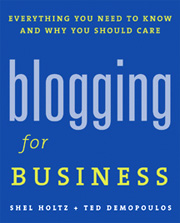
“Savvy companies that leverage the power of blogging will have a competitive advantage…[and] those that don’t understand the potential of this valuable tool will lag behind,” say authors and blogging experts Shel Holtz and Ted Demopoulos.
By way of their soon-to-be-published, new book, “Blogging for Business: Everything You Need to Know and Why You Should Care,” Holtz and Demopoulos are out to help businesses create blogs that lead to heightened awareness, greater customer mindshare, increased product sales – and, ultimately, profits.
I haven’t had the opportunity to read the entire book yet, but I have checked out some of it, and what I saw I liked – a lot. What particularly caught my attention were the following few paragraphs in the book’s introduction about blogs and the long tail…
The long tail is a notion introduced originally by Chris Anderson in Wired magazine. (Anderson continues to write about the concept on his own blog at http://www.thelongtail.com.) The article was about digital music, but the concept applies to innumerable aspects of the digital world, blogs among them. Here’s the idea:
A traditional music retailer – Tower Records or the Virgin Megastore, for example – has limited physical space in which to stock CDs. As a result, it stocks only the blockbuster hits that are most likely to move. Why stock a CD that one person might buy every five years when it can stock the latest J-Lo or Britney Spears CD that will fly off the shelves? If you picture a chart with x and y axes, these blockbuster hits soar up the left-hand side of the chart.
Digital music stores like Apple’s iTunes, Rhapsody, or Napster, on the other hand, have no such shelf-space restrictions. They can maintain the entire music catalog, including songs that haven’t seen radio airplay in 30 years. Looking at the same chart we suggested above for blockbusters [sorry, I can’t show you the chart here on A New Marketing Commentator – you’ll have to buy the book to see it], these items that don’t sell very many copies represent the long tail, a narrow line that trails off to the right.
Anderson found that the digital music stores were selling as much music from the long tail as they were from the list of blockbusters. While they may sell hundreds of Eminen CDs, they were also selling a few copies of old songs that, for example, somebody heard playing in an elevator, triggering an interest and prompting the purchase. In fact, consumers bought an unbelievably large percentage of the back catalog every month.
The long tail’s significance, then, is that in the digital world, you don’t need big numbers to have an impact.
And so it is in the blogosphere. Several pundits who haven’t yet figured this out dismiss all but a hundred or so blogs, the ones with large readerships. But you only need one reader to link to a post on your blog to elevate that post’s visibility in search engines. And if you get that one link, somebody else is likely to find your blog. Even if they don’t seek out your blog, but read only the post that referenced your original item, your influence is spreading.
Yes, the long tail concept most certainly applies to blogs, this one — A New Marketing Commentator — being a perfect example. My audience may pale in comparison to the readership of such popular blogs as Steve Rubel’s, Steve Hall’s, B. L. Ochman’s and Yvonne DiVita’s. But each of those blogs — among countless others — have linked to mine in the past, going a long way towards helping me broaden the reach of my marketing news and commentary.
As a blogger on the long tail, I may not have big numbers, but I can certainly have an influence in the blogosphere.
After all, in this day and age, as none other than Seth Godin says, “small is the new big.”
To learn more about “Blogging for Business: Everything You Need to Know and Why You Should Care” by Shel Holtz and Ted Demopoulos, including how to purchase your own copy, click here.
Google+ Follow
Follow


